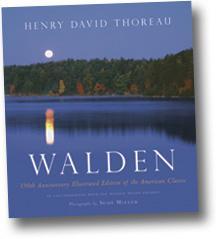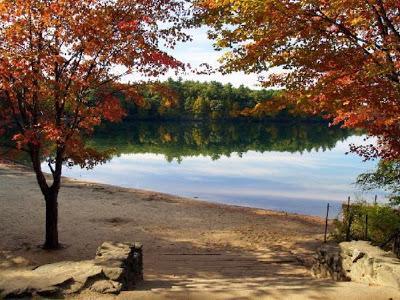An awareness of nature pervades the written word, whether poems, essays, short stories, novels, or newspaper and magazine articles. Here is an example at hand. I finished the gripping conclusion to Mary Higgins Clark’s A Cry In The Night , my latest mystery, at about 2 a.m. this morning. The opening paragraph of the concluding chapter reads like this:
“April broke over Minnesota like a godhead of plenty. The red haze haloed the trees as tiny buds begin to form, waiting to burst into bloom. Deer ran from the woods; pheasants strutted on the roads; cattle wandered far into the pastures; the ground softened and snow melted down into the furrows, nourishing the spring crops as they pushed their way to the surface.”And the novel’s vivid nature descriptions are not just literary window dressing. The harsh and gloomy Minnesota winter scenes, for example, help set the dark and suspenseful mood of the novel. This description of the change of seasons sets the scene for the happy ending.

Illustrated Edition of Walden with photos by Scot Miller - waldenat150.com/
No one has had more influence in creating this consciousness of the natural world than Henry David Thoreau (1817-1862). He left his mark on us through his journal (in at least 40 manuscript volumes) and other writings, most notably Walden; or Life in the Woods, written in 1854.

Walden Pond tripadvisor.com
I read Thoreau’s Walden while in college, when I was exploring new ideas and easily drawn to a rebellious mind. Thoreau was a key figure in the American Romanticist and Transcendentalist movement and a close friend of Ralph Waldo Emerson.
He is remembered as a champion of rugged individualism, marching to the beat of a different drummer, as he put it, but also self-reliance. He wrote in his journal:
“If you build your castles in the air, your work need not be lost; that is where they should be. Now put the foundations under them.”

"Full Moon Setting, Walden Pond" copyright Scot Miller
Walden was written about the two years, two months, and two days he spent in a 10 by 15 foot cabin he built in the woods near Concord, Massachusetts. He describes it as an experiment in simple living and self-sufficiency, and to have ample opportunity to write and reflect.He did this also to be “close to nature." As he said in Walden:
“One attraction in coming into the woods to live was that I should have the leisure and opportunity to see the Spring come in.”And this from Walden, what you might call the testament of the original tree-hugger:
“But no weather interfered fatally with my walks, or rather my going abroad, for I frequently tramped eight or ten miles through the deepest snow to keep an appointment with a beech tree, or a yellow birch, or an old acquaintance among the pines.”One of our cultural heroes of conservationism/environmentalism, his perspective was not primarily “saving the planet” from global warming and such, that nature needs us to rescue it; but rather that we need nature. He says in Walden:
“We need the tonic of wildness – to wade sometimes in marshes where the bittern and the meadow-hen lurk, and hear the booming of the snipe; to smell the whispering sedge where only some wilder and more solitary fowl builds her nest, and the mink crawls with its belly close to the ground.”Thoreau knew that we have to learn to love nature before we can want to preserve it.
According to Thoreau, nature teaches us, by its example and inspiration, such virtues as humility, simplicity, self-reliance and the value of solitude. Nature is a place to find ourselves and our self worth:
“I have a great deal of company in my house; especially in the morning, when nobody calls.”Nature also was for him a wellspring of the Spiritual. He persistently reminds us “to always be on the alert to find God in nature."

questgarden.com/90/38/2/091109193454/task.htm
A second influential work of Thoreau’s begs to be mentioned Civil Disobedience is as classic a statement as Thomas Jefferson’s Declaration of Independence of the rights of individuals over government. In particular, it eloquently argues for the right, and even duty, of individual conscience to defy unjust laws. Thoreau’s essay influenced Mahatma Gandhi in his resistance movement against British rule in India, and later Martin Luther King and the American Civil Rights Movement. “Civil disobedience” was an idea powerful enough to circle the world, and Thoreau’s phrase has stuck with us.
Even Thoreau’s ideas regarding moral duties, rights, and government are rooted in his spiritual and intellectual rapport with nature. The famous opening of Jefferson’s Declaration of Independence, “We hold these truths to be self-evident, that all men are created equal and endowed by their Creator with inalienable rights …” comes from the philosophical tradition of “natural law”, that nature itself declares basic principles of order, for both the natural and moral order.
But Thoreau is best remembered for his moving reminders of the beauty and inner significance of nature. Although he was a self-taught naturalist, it was always the poetry rather than the science of nature that most captured his attention. He remarked in his journal that,
“A man has not seen a thing who has not felt it."

alanmurphyphotography.com
His keen observations always seize on those breath-stopping moments, such as noting a blazing red and black Scarlet Tanager:“It flies through the green foliage as if it would ignite the leaves.”What more apt description: “The blue bird carries the sky on his back”; or that the haunting song of the Wood Thrush “declare the immortal wealth and vigor that is the forest.”
We would be the poorer without this rather eccentric, reclusive fellow who worked at odd jobs and went his own way in search of his unique destiny. Perhaps this from his journal sums it up: “If I am not I, who will be?”
